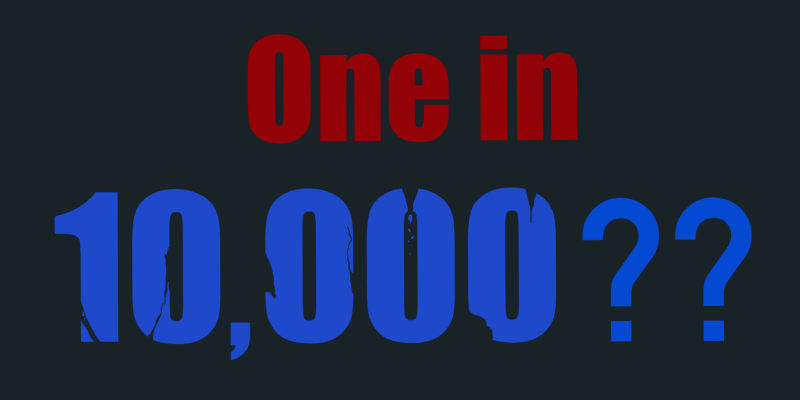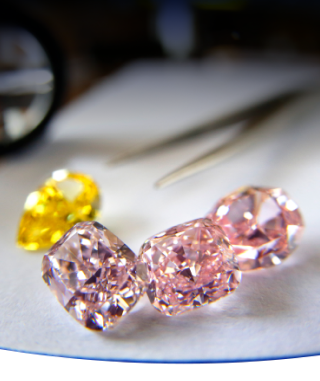Any professional in the diamond and jewelry industry will tell you that Fancy Color Diamonds account for one in every 10,000 unearthed diamonds; a simple Google search will support this foregone conclusion. The FCRF decided to track down the source of this widely-quoted statistic, when and how it came to be the only number used, and the importance of rarity figures to the end buyer.
The issue of Fancy Color Diamonds’ rarity has never really preoccupied the geological community. This may be because the industry relies on rough numbers, so it may not be necessary to chase down these elusive figures.
Hypothetically speaking, to come up with a rarity estimate of fancy color rough diamonds, a centralized body would need to collect data for several years from all mining companies, including small miners situated along stream-crossing forests in Brazil, Sierra Leone, and Indonesia, and carefully analyze their Fancy Color run-of-mine figures.
However, miners lack both the manufacturing experience and the ability to predict the polished result of each stone. For example, miners likely won’t be able to distinguish between a fancy light yellow to a Y-Z color, and a colorless diamond with a green “skin” in the rough, or know the polished yield or clarity of each stone. In short, accurately assessing the prevalence of Fancy Color Diamonds is simply impossible when rough data is the only thing you have.
The Man Behind “One in 10,000”
Sydney H. Ball (1877 – 1947) was an American geologist and mining engineer who spent the early part of his career in public service. In 1907, Ball decided to join the “Mission de Recherches Minieres,” — led by Ryan Guggenheim — that searched for deposits of gold, copper, and coal in the Belgian Congo. During the two years Sydney Ball and his delegation spent in the Congo, incidentally, their lives were saved numerous times by Belgian soldiers when they faced attack by armed, local cannibals. The expedition ended in 1909, by which time it had uncovered valuable diamond deposits at Tshikapa, one of several diamond deposits in the country. Upon his return to the US, Ball authored several academic works, articles, and books about geology, mining, and minerals.
In 1935, Ball published an article in the inaugural volume of the GIA’s Gems & Gemology. In the article, he presented his findings as well as those of other geologists from earlier periods. Ball quoted mineralogists such as John Mawe who discussed Brazilian colored diamonds in 1813, and Thomas Nicols, who wrote about colored diamonds in 1652. In his writings, Ball discussed his admiration for specific-colored diamonds and gave an overview of the firsthand knowledge he gained in his years in the Congo. Among the gemmological findings he described, Hall expressed his opinion on the global scarcity of fancy color diamonds:
“No adequate figure exists as to how rare fancies are. I am inclined to believe, however, that of the total world’s diamond production to date, including of course much material wholly unsuitable for gems, that fancies make up but about 1/100 of a percent (i.e. 1 in 10,000) of the total.”
The Evolution from a Metaphor to a “Fact”
We could not determine when exactly “one in 10,000” became the accepted figure, but it likely gained momentum in the late 1990s, when the need to elevate the rarity factor and reinforce the investment element of Fancy Color Diamonds arose.
Although this number was based on Sydney H. Ball’s quote from the 1930s, because the GIA echoed it into a void repeatedly, it became the only available “statistic” on Fancy Color Diamonds. Surprisingly, “one in 10,000” is still used in most marketing materials related to Fancy Color Diamonds, all based on an incidental statement published by the GIA. John King, a renowned GIA authority in Fancy Color Diamonds who compiled and edited the famous GIA book Gems & Gemology in Review: Colored Diamonds, commented on the “one in 10,000” statistic:
“I have always believed the figure comes from very general knowledge and assumptions at a given time and, as much as anything, an effort to create a decent metaphor for rarity. Over time, I believe the industry, looking for direct sound bites, has turned metaphor into ‘fact’.”
Mapping Rarity
According to the Natural Diamond Council, the weight of the average unearthed rough diamond is 0.03 carat (yielding a ~0.01 in the polish), which means that most polished diamonds fall into a weight category that is irrelevant in a discussion about rarity with a consumer. Therefore, any rarity discussion about Fancy Color should focus on diamonds that are large enough to stand alone.
According to FCRF Rarity Report submissions, interest in rarity data deals mainly with diamonds sized one carat and above. Just 20% of submissions regard diamonds between 0.50 to 0.99 carat, which leaves a very large number of stones out of the equation (those below 0.50 carat). We also see a connection between diamonds with a higher gemological grade and the need for rarity data to support their high value. For example, there are generally more Rarity Report requests for a one carat Vivid Blue than a one carat Fancy Light Blue.
As for today’s global rough diamond reserves, there are more polished diamonds mounted in jewelry than the estimated number of unearthed rough diamonds. This means that any number that reflects scarcity must include polished diamonds that circulate back from the second-hand market, especially as many of them go through a re-cut that improves their gemological characteristics and enter the market as a new diamond. Between the figures of rough size, the second-hand market, and the actual rarity interest in larger stones, it seems that the “one in 10,000” metaphor is no longer relevant. Evidently, the ideal way to address the rarity of Fancy Color Diamonds would be through the prevalence of polished diamonds entering the market over time. Hence, we have to consider the number of polished diamonds by their gemological characteristics entering the market every year, or once every several years, regardless of whether they are unearthed, preowned, or re-cut.
The Right Way to Use Rarity
The rarity of polished Fancy Color Diamonds results from two fundamental elements: Those caused by nature and those created by humans. Natural causes impact the initial size of the rough, hue, undertone, intensity, and inclusions arrangement in a diamond. Human decisions impact the shape, final weight, and sometimes even the saturation and clarity of a diamond.
Different planning decisions by different manufacturers have a dramatic effect on a diamond’s outcome. For example, the same 10 carat rough yellow Fancy Color Diamond could be turned into a 5 carat Pear Shape, SI1 clarity or into a 4.80 carat Oval with a VS clarity. Two different outcomes that lead to different rarity results, from the same exact rough.
The rarity question today is an integral part of the conversation around Fancy Color Diamonds, especially during a sale ceremony between a jeweler and a diamond lover. It greatly enhances the story-telling of this luxurious article, and can support the concept of long-term wealth preservation. When it comes to rarity stats, it is important to note that because there are multiple variables, an absolute rarity number cannot be reached. However, it is possible to reach a rarity range, which could, in fact, present an accurate picture. Multilayered data that is collected and analyzed makes it possible to assess the approximate number of appearances of most Fancy Color Diamonds over time, which is a vital piece of information that never existed before.
Fancy Color Diamond buyers are the most savvy buyers in the jewelry space. These collectors are drawn to Fancy Color Diamonds because they are alluring and represent something special that cannot be duplicated. At best, one can buy a diamond with similar characteristics.
Because the approach to Fancy Color Diamonds overlaps with other luxury items such as art, collectible watches, vintage cars etc., buyers, nowadays, look for ways to quantify the rarity of their specific item. An art buyer cares only that their Andy Warhol print is one in twelve ever created, while unconcerned with the prevalence of all prints in the world. The owner of the new Patek Philippe with a Tiffany dial cares that his particular model was produced in a series of 170, while indifferent to the fact that his watch is one in a few million ever produced by the brand. Because sophisticated collectors want to know how special their acquisition is, a meaningful discussion should revolve around this question also when talking about Fancy Color Diamonds.
Whether a buyer decides to start a jewelry collection with a small Fancy Yellow or a multimillion-dollar Vivid Pink, a metaphoric figure like “one in 10,000” no longer tells a story of a specific fancy color diamond, nor does it support the wealth preservation element that collectors seek. Buyers are more enthusiastic when a seller puts their stone into a meaningful context that brings out real value. Therefore, for impactful transactions, jewelry sellers may want to adopt a more personalized, relevant, and context-rich approach to rarity.


